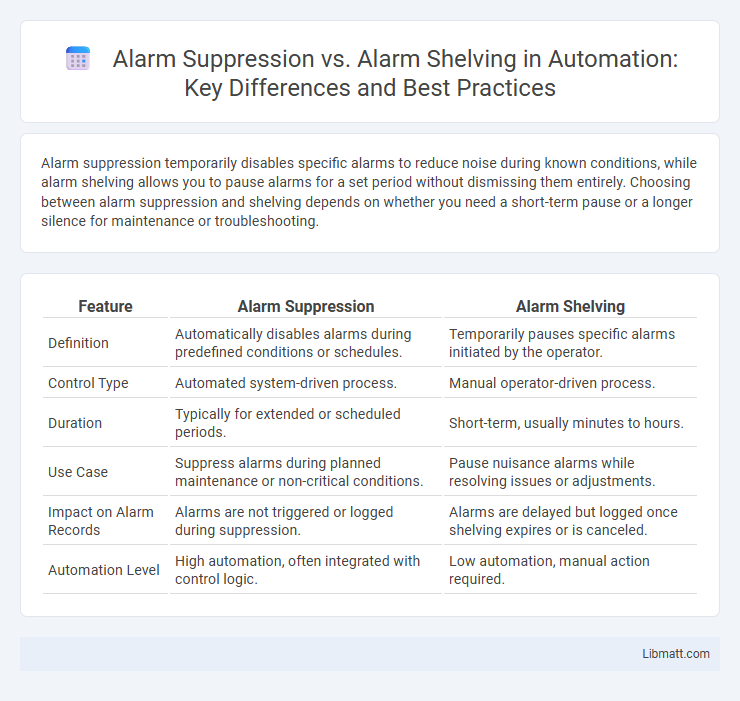Alarm suppression temporarily disables specific alarms to reduce noise during known conditions, while alarm shelving allows you to pause alarms for a set period without dismissing them entirely. Choosing between alarm suppression and shelving depends on whether you need a short-term pause or a longer silence for maintenance or troubleshooting.
Table of Comparison
| Feature | Alarm Suppression | Alarm Shelving |
|---|---|---|
| Definition | Automatically disables alarms during predefined conditions or schedules. | Temporarily pauses specific alarms initiated by the operator. |
| Control Type | Automated system-driven process. | Manual operator-driven process. |
| Duration | Typically for extended or scheduled periods. | Short-term, usually minutes to hours. |
| Use Case | Suppress alarms during planned maintenance or non-critical conditions. | Pause nuisance alarms while resolving issues or adjustments. |
| Impact on Alarm Records | Alarms are not triggered or logged during suppression. | Alarms are delayed but logged once shelving expires or is canceled. |
| Automation Level | High automation, often integrated with control logic. | Low automation, manual action required. |
Introduction to Alarm Management
Alarm suppression and alarm shelving are critical techniques in alarm management designed to reduce alarm fatigue and improve operator response efficiency. Alarm suppression temporarily blocks alarms based on specific conditions or system states, preventing unnecessary alerts during known, benign events. Alarm shelving allows operators to manually postpone alarms, providing controlled flexibility for managing nuisance alarms without disabling critical alarm functionality.
Defining Alarm Suppression
Alarm suppression refers to the temporary disabling of specific alarms based on predefined conditions to prevent unnecessary notifications during planned activities or known system states. This method ensures that only critical and actionable alarms reach your attention, reducing alarm flooding and increasing operational efficiency. Unlike alarm shelving, which is a user-initiated pause of individual alarms, suppression operates automatically according to system rules and parameters.
Understanding Alarm Shelving
Alarm shelving is a temporary pause of specific alarm notifications, allowing operators to focus on resolving known issues without being distracted by repetitive alerts. Unlike alarm suppression, which can inhibit alarms across broader systems or conditions, shelving targets individual alarms for a defined time period, preserving alert integrity while managing alarm fatigue. Understanding alarm shelving is crucial for optimizing alarm management strategies and maintaining system safety and efficiency.
Key Differences Between Suppression and Shelving
Alarm suppression temporarily disables alarms based on predefined conditions to prevent unnecessary notifications during known events, while alarm shelving pauses alarms for a user-defined period without changing their underlying logic. Suppression operates automatically within system settings, targeting specific alarms or groups, whereas shelving requires manual user intervention to silence alerts temporarily. Your choice between alarm suppression and shelving depends on whether you need automated control or flexible, short-term alarm management.
Advantages of Alarm Suppression
Alarm suppression offers significant advantages by automatically filtering non-critical or redundant alarms, reducing noise and preventing alarm fatigue in high-pressure environments. This ensures that Your attention remains focused on truly urgent situations, enhancing operational efficiency and safety. Moreover, alarm suppression supports better compliance with industry standards by maintaining clear and relevant alarm records for analysis.
Benefits of Alarm Shelving
Alarm shelving enhances operational efficiency by temporarily pausing non-critical alarms, allowing technicians to focus on higher-priority issues without distraction. This targeted approach reduces alarm fatigue and improves response accuracy, as suppressed alarms are managed selectively rather than disabled entirely. Shelving also provides a clear audit trail for temporary alarm states, supporting compliance and continuous improvement in alarm management practices.
Operational Scenarios for Each Method
Alarm suppression is ideal for temporarily disabling alarms during planned maintenance or testing, preventing unnecessary notifications that could lead to operator desensitization. Alarm shelving suits scenarios where specific alarm conditions are acknowledged but require deferred action, allowing operators to focus on more critical events without losing track of pending alarms. Your choice between these methods depends on whether the aim is to mute alarms proactively or to postpone response while maintaining situational awareness.
Best Practices for Alarm Handling
Alarm suppression and alarm shelving are critical components of effective alarm management, with suppression temporarily preventing alarm notifications based on specific conditions, while shelving allows operators to manually pause alarms during planned activities. Best practices for alarm handling emphasize defining clear criteria for when to suppress versus shelve alarms to avoid alarm fatigue and ensure timely operator response. Implementing automated rules for suppression combined with operator-driven shelving, along with continuous review of alarm rationalization, optimizes system reliability and safety in process industries.
Impact on Safety and Compliance
Alarm suppression temporarily disables alarms, potentially compromising safety by delaying critical alerts and increasing the risk of undetected hazardous conditions, which may lead to non-compliance with safety regulations. Alarm shelving, on the other hand, pauses alarms but maintains visibility, allowing operators to monitor conditions and respond promptly without ignoring safety protocols. Your choice between suppression and shelving directly affects operational safety and regulatory compliance by balancing alarm management with real-time risk awareness.
Choosing the Right Approach for Your Facility
Selecting the appropriate method between alarm suppression and alarm shelving depends on your facility's operational goals and risk management strategy. Alarm suppression temporarily blocks non-critical alarms during specific conditions to reduce nuisance alerts, while alarm shelving allows operators to pause certain alarms for a defined period, maintaining visibility for significant events. Understanding the distinction ensures effective alarm management, enhances safety, and minimizes alarm fatigue in industrial environments.
Alarm Suppression vs Alarm Shelving Infographic

 libmatt.com
libmatt.com